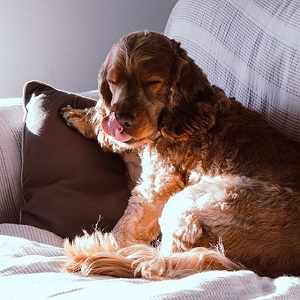Creating a safe space for your blind pet is crucial, especially in the early days when they are creating a mental map of their home. For a dog or cat that has just lost their vision, they will be very confused about their surroundings, by eliminating any hazards that will spook or hurt them, they will quickly build their confidence. Below are our top tips and advice:
1. Baby-proofAs strange as it sounds, bringing a home a blind dog is a little like having a toddler running around the house; you need to cover sharp corners, use gates if you have stairs, and eliminate tripping hazards. Try getting on your hands and knees to make sure you are not missing anything; you might find something you did not notice at first.
2. Decide on a floorplan and stick to itIf you have a blind pet then re-decorating your home often is out of the picture. Your pet will be making a mental map of their home and even a slight change can confuse them. At the beginning, if we forgot to push in a chair when we got up and Stevie bumped into, you can tell it really threw her off and shook her confidence a bit.
3. Clean up after yourselfWho knew having a blind dog or blind cat would lead to having a cleaner home? Long gone are the days where we would come home, kick off our shoes, and leave them there until the next time we put on. One of the first things we bought when we brought home Stevie was a shoe cabinet to put at our front door. Now, as soon as we come home, we put our shoes in the cabinet leaving the area clear for Stevie. If you have children, have a talk with them about the importance of cleaning up their toys or games for their blind sibling. 4. Use carpets or floor runners
When your dog loses their sight, their other sense will be heightened including the pads on their paws. By using various carpets or floor runners in your home, your pet will use the change in texture as a marker indicating they have moved into t a different room in the house. In the kitchen, for example, we have tiled floors but use a large mat where Stevie’s food and water are kept.
5. Make the change to a water fountainWe have used a water fountain for Stevie’s water dish since the beginning. Initially we got a water fountain so she could use the noise to guide her to where her food and water were, but we also thought it was nice for her to constantly have a background noise in the home. The water fountain, or any constant noise, acts as a point of reference for your dog to use when they are navigating the home. If they get confused and their mental map is off, the point of reference noise can help re-orient themselves.
6. AccessibilityPut yourselves in your pet’s shoes….er, paws… to see what their accessibility will be like in your home. One thing that made Stevie more independent in the home was by simply adding stairs to the couch. The couch is Stevie’s favorite place to hang out and she could jump onto the couch fearlessly, but once she was up, she was too afraid to jump down. We were worried about leaving for the day and having her stuck on the couch, unable to access her food and water. By adding stairs or a ramp to the higher places your pet will frequent will add independence to their life!
7. Don’t forget the yardIf you have a yard, do not forget to check this area for potential hazards. You might consider putting in a fence and checking the yard for holes. If you have a pool make sure there is a cover on it when you are not using it. In fact, if you bring your dog outside unattended it is best to leave them on a leash. Blind cats should become indoor cats, despite how much they might want to go outside.
8. Use a leash to introduce them to a new areaIf you are bringing your dog home for the first time after going blind or after moving to a new home, use a leash to walk them around for the first couple of days.
